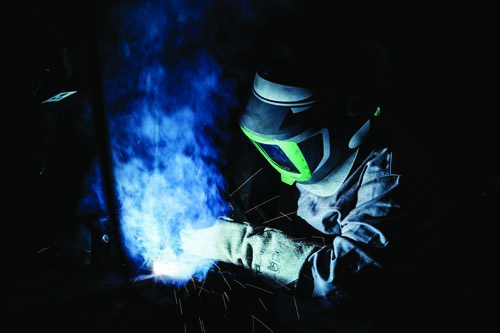Weighing the options
What are the benefits of a loose-fitting respirator versus a tight-fitting respirator?

Responding is Megan McConville, digital lead and content specialist, RPB Safety, Royal Oak, MI.
Today’s advancing technology presents industrial workers with a wide range of choices when selecting respiratory protection. Weight, features, capabilities, fit and even style – sometimes the number of options can be overwhelming.
Bells and whistles aside, arguably the most important factor to consider should be the operator’s safety and health. Users need to assess their environment and risks to determine what type of respirator will offer them the highest level of protection. One of the key choices is deciding between a tight-fitting or a loose-fitting respirator.
What’s the difference?
Respirator type is determined by the seal. Tight-fitting respirators – half-face or full-face – require a tight seal between the respirator and the face and/or neck of the operator. Conversely, loose-fitting respirators – typically a hood covering the user’s head and shoulders – provide protection without requiring a tight seal against the face.
A look at some of the main areas of protection indicates that loose-fitting respirators can offer several important safety benefits over tight-fitting respirators.
Seal effectiveness. Because tight-fitting respirators require a tight seal to be effective, anything that may interfere with that seal can compromise the user’s protection and shouldn’t be permitted. This includes things as small as facial hair and piercings. Even just a half day’s worth of facial hair growth can break the seal on a tight-fitting respirator.
Fit testing is required before the first use and again at least every 12 months. User seal checks are required every time a respirator is put on. Conversely, because loose-fitting respirators don’t rely on a tight seal, operators can maintain whatever facial hair they choose (when adhering to usage per the respirator manufacturer’s guidelines) without worrying about contaminating their breathing air. Loose-fitting respirators don’t require fit testing or seal checks.
Certified head protection. Although tight-fitting respirators often are seen as less bulky and more comfortable to wear, they don’t provide head protection. Some loose-fitting respirators come with built-in head protection, while others have a hard hat option – providing an extra level of safety.
Hearing protection. Half-face and full-face tight-fitting respirators don’t have built-in hearing protection capabilities. As hearing protection is recommended in noisy environments, users of tight-fitting respirators need to employ extra equipment such as earplugs or earmuffs. Some loose-fitting respirators come with optional built-in hearing protection, offering users higher levels of noise reduction without additional equipment.
Rebound/overspray protection. A tight-fitting respirator covers only a precise area of the operator’s face, so the user is still susceptible to exposure to rebound or overspray on unprotected areas. Half-face respirators provide only mouth and nose protection, and users need safety glasses for eye protection, whereas full-face respirators cover the operator’s entire face.
Loose-fitting respirators cover more facial area, providing greater coverage protection from rebound or overspray and offering built-in eye protection. Bib options can cover the user’s torso and head for additional coverage.
In summary
Users should always take the time to assess their own needs, their environment and the risks it poses to select the best respiratory protection for their application. No matter which respirator is chosen, operators should always follow the manufacturer’s guidelines to ensure the respirator is protecting them to its highest ability.
Editor's note: This article represents the independent views of the author and should not be construed as a National Safety Council endorsement.
Post a comment to this article
Safety+Health welcomes comments that promote respectful dialogue. Please stay on topic. Comments that contain personal attacks, profanity or abusive language – or those aggressively promoting products or services – will be removed. We reserve the right to determine which comments violate our comment policy. (Anonymous comments are welcome; merely skip the “name” field in the comment box. An email address is required but will not be included with your comment.)

